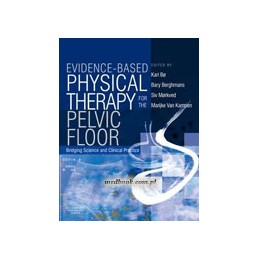- Obniżka


 Dostawa
Dostawa
Wybierz Paczkomat Inpost, Orlen Paczkę, DHL, DPD, Pocztę, email (dla ebooków). Kliknij po więcej
 Płatność
Płatność
Zapłać szybkim przelewem, kartą płatniczą lub za pobraniem. Kliknij po więcej szczegółów
 Zwroty
Zwroty
Jeżeli jesteś konsumentem możesz zwrócić towar w ciągu 14 dni*. Kliknij po więcej szczegółów
This unique book bridges the gap between evidence-based research and clinical practice in physical therapy for pelvic floor dysfunction. A cast of highly experienced specialists is headed up by an internationally renowned editorial team of pioneering researchers and teachers. Each treatment chapter starts with a focus on evidence from basic studies (theories or rationales for the treatment) and RCTs (appraisal of effectiveness); this is then comprehensively linked to the implications for clinical practice and followed up with recommendations on how to start, continue and progress treatment. This text is essential for all forward-thinking clinicians specializing in the pelvic floor and looking for innovative practice guidelines backed with a sound evidence base.
Opis
1. Overview of physiotherapy for pelvic floor dysfunction. 2. Critical appraisal of randomised trials and systematic reviews of the effects of physiotherapy interventions for the pelvic floor. 3. Functional anatomy of the female pelvic floor. 4. Neuroanatomy and neurophysiology of pelvic floor muscles. 5. Measurement of pelvic floor muscle function and strength + pelvic organ prolapse: 5.1 Introduction; 5.2 Visual observation and palpation; 5.3 Electromyography; 5.4 Vaginal squeeze pressure measurement; 5.5 Urethral pressure measurements; 5.6 Pelvic Floor Dynamometry; 5.7 Ultrasound in the assessment of pelvic floor muscle and pelvic organ descent; 5.8 MRI of intact and injured female pelvic floor muscles; 5.9 Clinical assessment of pelvic organ prolapse. 6. Pelvic floor and exercise science: 6.1 Motor Learning; 6.2 Strength Training. 7. Strategies to enhance adherence and reduce drop out in conservative treatment. 8. Lifestyle interventions for pelvic floor dysfunction. 9. Pelvic floor dysfunction and evidence-based physiotherapy: 9.1 Female stress urinary incontinence (SUI); 9.1.1Prevalence, Causes, Pathphysiology: Two views, one disease; 9.1.2 Pelvic floor muscle training for SUI; 9.1.3 Electrical stimulation for SUI; 9.2 Overactive Bladder (OAB); 9.2.1 Introduction; 9.2.2 Bladder training for OAB; 9.2.3 Pelvic floor muscle training for OAB; 9.2.4 Electrical stimulation for OAB; 9.3 Pelvic Organ Prolapse (POP); 9.3.1 Introduction; 9.3.2 Pelvic floor muscle training in the prevention and treatment of POP; 9.4 Pelvic Pain; 9.4.1 Pelvic floor muscle assessment; 9.4.2 Treatment of pelvic floor muscle pain and/or overactivity; 9.5 Female Sexual Dysfunction; 9.6 Male sexual dysfunction; 9.7 Fecal Incontinence. 10. Evidence for pelvic floor physiotherapy for urinary incontinence during pregnancy and after childbirth. 11. Evidence for pelvic floor physiotherapy for neurological diseases: 11.1 Stroke; 11.2 Multiple Sclerosis. 12. Evidence for pelvic floor physiotherapy in the elderly. 13. Pelvic floor physiotherapy in elite athletes. 14. Evidence for pelvic floor therapy in men. 15. Evidence for pelvic floor therapy in children. 16.The development of Clinical Practice Guidelines in physiotherapy.
Joint Annual Meeting of the International Continence Society (ICS) and International Urogynecological Association (IUGA)
23-27 August, Toronto, 2010
Discover breakthroughs in continence research & treatment from experts in the fields of uro-gynaecology at ICS-IUGA 2010.
Register Now: www.ics-iuga.com
